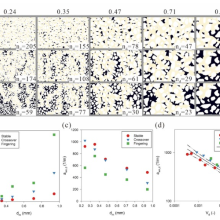New SFB 1313 publication, published in "Journal of Hydrology". The work has been developed by researchers involved in Project Areas B, C, and the Porous Media Lab.
Authors
- Huhao Gao (University of Göttingen)
- Hiwa Abdullah (University of Göttingen)
- Alexandru-Bogdan Tatomir (University of Göttingen)
- Nikolaos Karadimitriou (University of Stuttgart, research project Z-02)
- Holger Steeb (University of Stuttgart, SFB 1313 spokesman, research project Z-02 B-05 C-05)
- Dejian Zhou (University of Göttingen)
- Quan Liu (University of Göttingen)
- Martin Sauter (University of Göttingen, Leibniz Institute for Applied Geophysics, Hannover)
Abstract
This study investigates the capillary-associated interfacial area during primary drainage in unconsolidated porous media for different mean grain diameters, employing pore-scale numerical simulation with the phase-field method. Five, two-dimensional porous media are generated with the same grain/pore size uniformity, but different mean grain diameters, ranging between 0.24 mm and 0.94 mm. Three cases are considered, representing stable displacement, crossover zone and viscous-fingering regimes. The findings reveal that the capillary-associated interfacial production rate increases with decreasing grain size. Specifically, the capillary-associated interfacial production rate is higher for the viscous-fingering regime compared to the stable displacement. The maximum capillary-associated interfacial area obtained for different grain sizes agrees with the correlation established in our previous study using the kinetic interface-sensitive tracer. Furthermore, the capillary-associated interfacial area is divided into two parts: one related to the disconnected water clusters and the other related to the connected water. The disconnected capillary-associated interfacial area correlates with the average volume of the clusters, following an exponential function. Furthermore, the average volume of the clusters depends on both, the grain size and displacement regime. Moreover, it is found that the displacement regime has a great impact on the connected capillary-associated interfacial area. For stable displacement, the connected capillary-associated interfacial area is larger for larger mean grain diameter. In contrast, for fingering, the connected capillary-associated interfacial area is smaller for increasing mean grain diameter.


